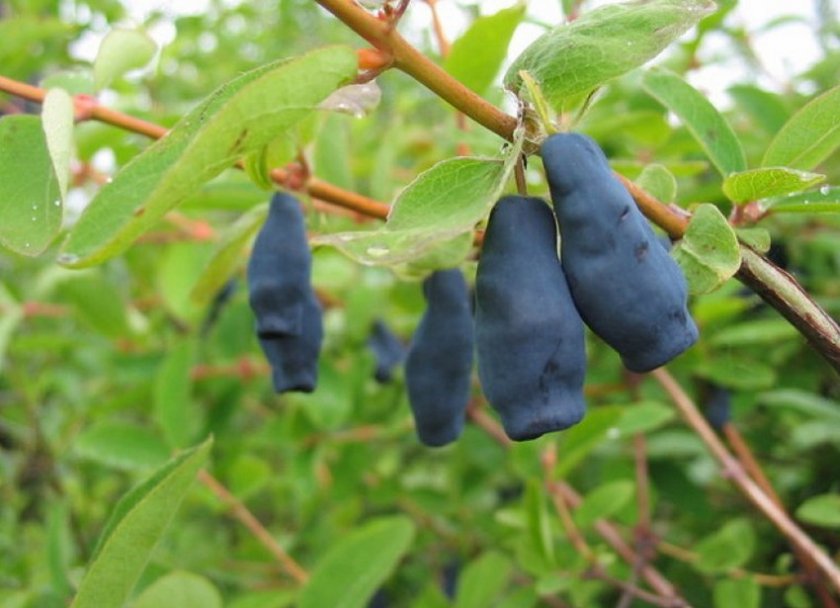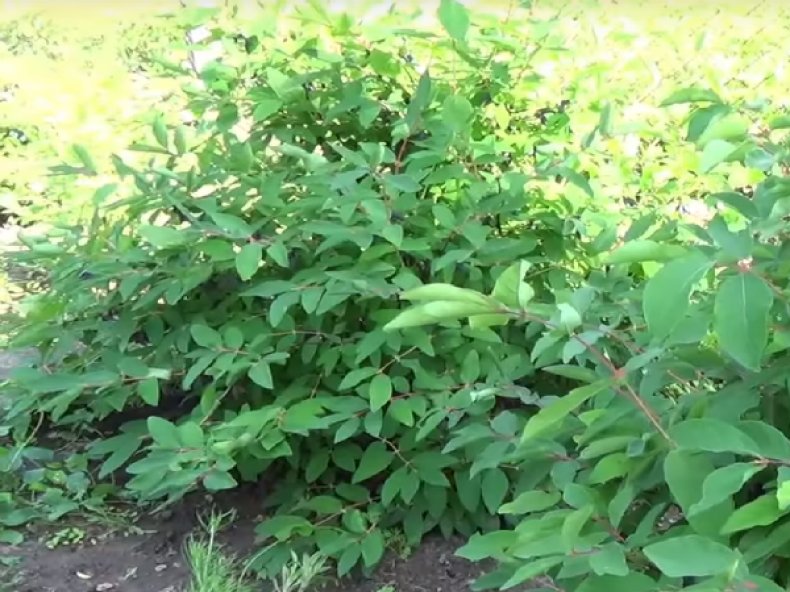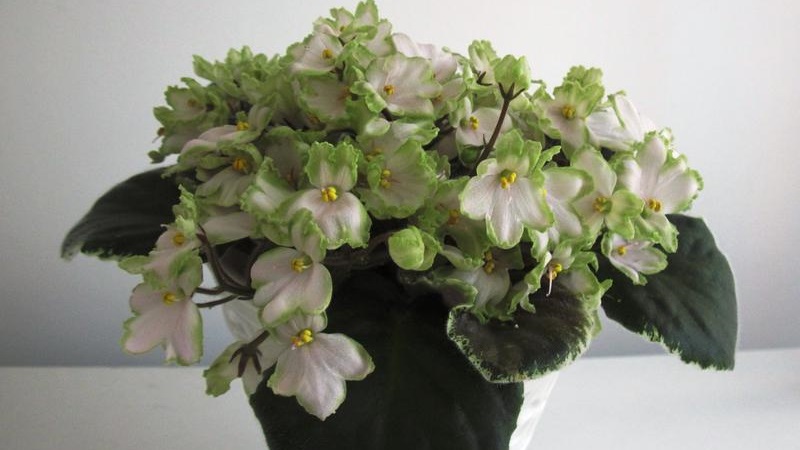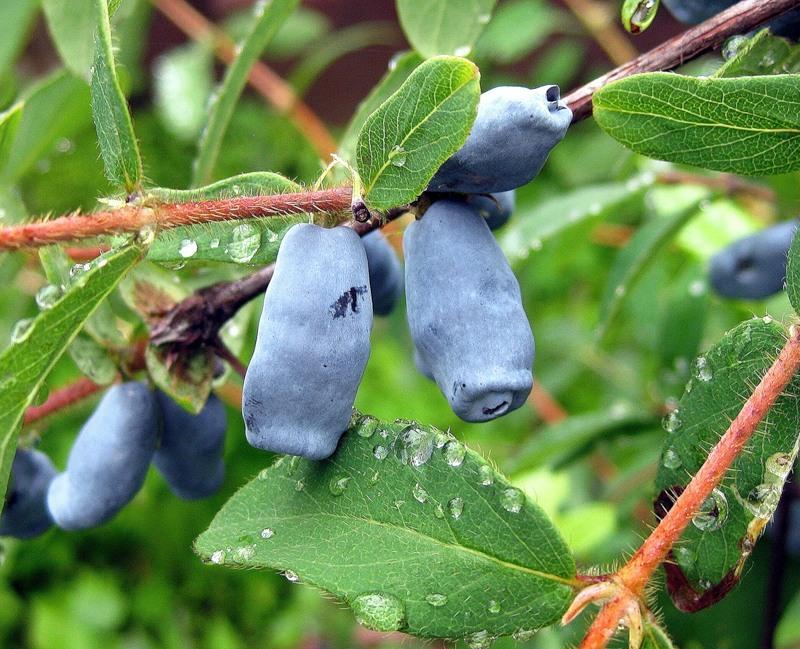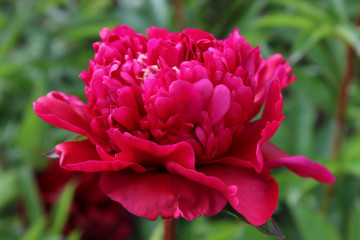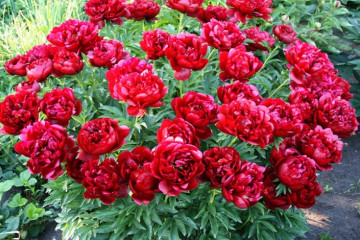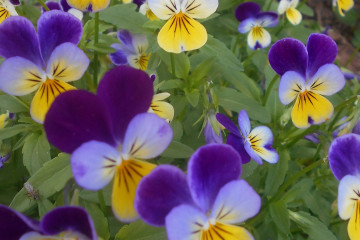Honeysuckle "Violet" - features of cultivation
Content:
Honeysuckle is subdivided into decorative and edible. Violet is a cultivar with healthy and tasty blue-violet fruits. She is unpretentious in care, has good immunity. Further, a description of the Violet honeysuckle variety, information on growing crops in the garden.
Honeysuckle variety Violet - what it looks like, which family it belongs to
Honeysuckle Violet is a crop with medium-sized shoots. Edible fruits are formed after spring flowering. The culture belongs to the Honeysuckle family (lat.Lonícera).
Description
Honeysuckle shoots reach a height of 1.5 m. Leaf plates are green, oblong. The flowers are medium in size, painted in a pale green palette.
Fruits are oblong, lumpy. Their weight is 1.2-1.5 grams, length is 2.8-3 centimeters. The skin is colored blue-violet. The surface of the fruit is covered with a waxy bloom. The pulp is fibrous, sweet on the palate, with a slight sourness.
History of appearance
This variety was bred by the breeders of the Pavlovsk Experimental Station. They pollinated the seed material of the Roksolana variety. Then it was tested by specialists from the Krasnout Experimental Station, located in Ukraine.
Habitat
In 1995, the variety was approved and recommended for cultivation in all regions of Russia. In Ukraine, the Violet honeysuckle variety will best develop in the northern regions.
Violet species Japanese honeysuckle
The famous breeder Elena Lebetskaya bred Saintpaulia with similar flowers. By analogy, it was given the name: violet LE Japanese honeysuckle (japan zhimolost).
Features of honeysuckle care
Crop care consists in timely watering, mulching, periodic feeding, and autumn pruning.
Watering
A small tree is watered as needed. The top layer of soil should have time to dry out. If there is a lot of rainfall during the summer, additional watering is not required.
Spraying
The plant can infect a disease and a pest. For prophylaxis in the spring, it is sprayed with special preparations - most often Bordeaux liquid is used.
Humidity
The thickened crown is poorly ventilated, droplets of moisture remain in it for a long time. High humidity can contribute to the appearance of fungal diseases. Therefore, the crown must be thinned out, and watering must be done at the root.
Priming
A honeysuckle called Violet develops best on light, fertile soils with a neutral reaction. In heavy, clayey soil, moisture stagnation will occur.
Top dressing
Fertilizing the soil begins in the 3rd year after planting. The frequency of application is as follows:
- for the development of green mass in early spring, nitrogen-containing substances are used;
- bird droppings or manure are introduced in May;
- in September, the bushes are fed with potassium and phosphorus.
Pruning
For sanitary purposes, dry, broken, diseased branches are cut in autumn. In addition, shoots growing inward are removed. You cannot shorten them, otherwise the gardener will not wait for the harvest this year.
Rejuvenating pruning is periodically carried out: 5-6 shoots are left in an adult bush, the rest are cut at the root.
When and how honeysuckle blooms
Violet honeysuckle is characterized by early flowering and fruit ripening.
- Flower shape
On the shoots of Violet, 2-centimeter five-petal flowers are formed. During the formation period, they are colored with a pale green palette. During complete dissolution, the color changes to white.
- Flowering period
The plant blooms in May. In late spring or early summer, oblong fruits of blue-violet color are formed.
Honeysuckle fruit
The tasters rated the palatability of the aromatic Violet berries at 4.7 points out of 5.
The fruit resembles a jug in shape. Their surface is slightly bumpy, the skin is thin, but dense. The color of the berries is blue-violet, the taste is sweet-sour, with a pleasant aroma.
Why berries are useful and how are they used
The fruits contain a large amount of nutrients. They help to increase immunity, strengthen the walls of blood vessels, lower blood pressure, and remove salts of heavy metals.
Berries are consumed fresh, jams, compotes, jelly are cooked from them. The fruits are added to salads, mousses and cocktails are prepared from them. In addition, the berries are dried and frozen.
Harvesting
Ripening of honeysuckle fruits is uneven. The berries below begin to sing. Therefore, the harvest is carried out gradually. The procedure is performed in dry weather.
Features of growing honeysuckle
Violet begins to bear fruit early, so it should be planted in the ground in the fall. The site is selected carefully, since the culture can grow in one place for up to 25 years.
Planting bushes
The seedlings are purchased from a nursery or garden center. They must be 2 years old, 30-40 centimeters high. Healthy bushes have no dents or spots on the surface of the shoots, the roots are alive on the cut.
Honeysuckle prefers to grow in a well-lit area. In this case, the berries will be sweet, aromatic. The procedure for planting bushes is as follows:
- dig holes 50 × 50 × 50 centimeters in size;
- fill them with a nutrient mixture;
- plants are installed in the middle of the holes, the roots are straightened;
- covered with earth, slightly tamped;
- watered abundantly.
Pollination
Honeysuckle called Violet is not self-fertile. Therefore, pollinating plants need to be planted nearby.
The best varieties of honeysuckle for this: Amphora, Viola, Blue Spindle.
Possible growing problems
The culture has good immunity, but with mistakes in care, it can be affected by various diseases and pests.
Advantages and disadvantages of the variety
The positive qualities of the variety include the following characteristics:
- unpretentious care;
- frost resistance;
- early terms of fruiting;
- good immunity of the bushes;
- excellent taste of fruits;
- weak crumbling.
Negative qualities include the need to plant a number of pollinator varieties.
Diseases
With heavy rainfall or frequent watering, honeysuckle can be affected by fungal diseases. At the same time, spots, a whitish bloom appear on the shoots and leaves. Fungicides are used to combat pathogenic microorganisms.
Pests
Honeysuckle can be attacked by: scale insects, aphids, spider mites. They suck out cell sap from the foliage, weakening the bushes. Insecticides are used against harmful insects. To prevent their appearance, plants are sprayed in spring with Aktara, Decis.
Other problems
Fruits on plants are formed in the 3rd year after planting. If, after the specified time, fruiting has not begun, this means that pollinating varieties were not planted next to the honeysuckle, or they are not suitable for pollination of the crop.
Violet is a variety of honeysuckle with delicious, edible fruits. The plant is unpretentious in care, it is frost-resistant. With good care, a gardener from a bush can collect about 1.8 kilograms of blue-purple beneficial berries.
